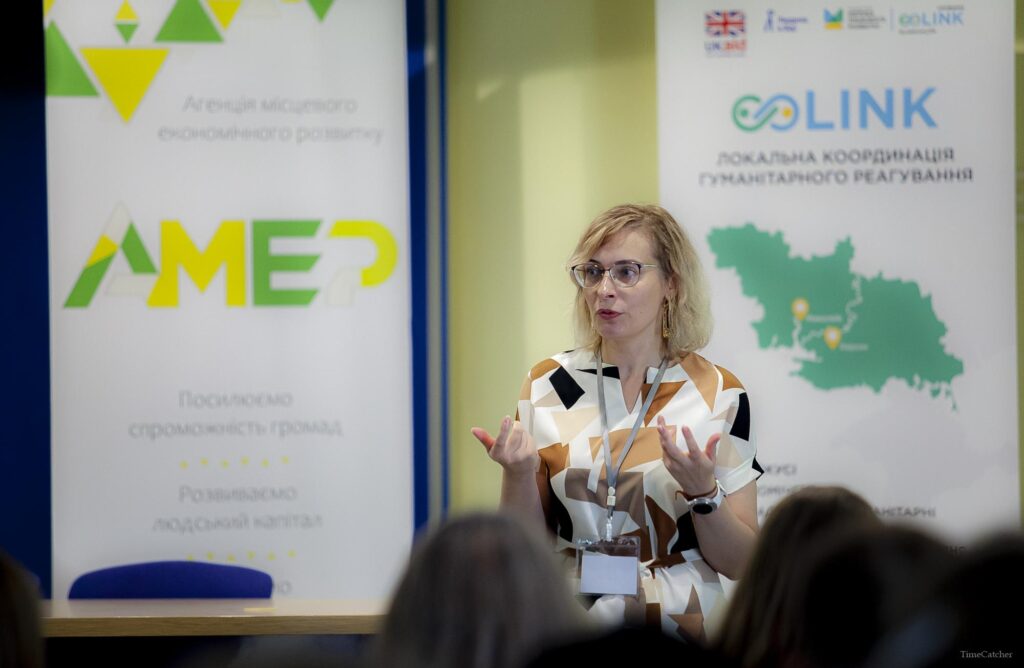Local Humanitarian Aid Coordination in De-occupied Communities: Link Platform Experience in Mykolaiv and Kherson Oblasts
Publication date: January 24, 2025
Author: Halyna Kolesnik, Head of the Communication Cluster at the Legal Development Network
De-occupied communities in Kherson and Mykolaiv regions continue to suffer from constant shelling, which significantly complicates the delivery of humanitarian aid to the most affected settlements. The Link platform ensures effective interaction between communities and humanitarian organizations, helping to overcome these challenges. We will now discuss how the community context influences the Link mechanism, which is being implemented by the Legal Development Network in partnership with the Czech humanitarian organization “People in Need” and funded by the British government.
Today, data collection specialists receive information from 24 de-occupied communities in Mykolaiv and Kherson regions. To be able to verify needs from two or more sources every 14 days in 2024, Link platform offices have started operating not only in Mykolaiv, but also in Zelenodolsk, Dnipropetrovsk region, and Kherson.
Kherson Region
Working under Constant Shelling

“Our Link platform office in Zelenodolsk works with eight communities in the Kherson region. Only three are in a relatively safe condition. In another three communities, only one settlement from the entire community is somewhat safe — where the heads of military administrations are located. The rest are under constant shelling — about 70 percent are in a gray zone that no one can even reach. And two communities are constantly under fire. Some territories are periodically shelled, but again, these are dangerous places. Therefore, many organizations we work with refuse to go there and don’t know what’s happening. According to their protocols — these are red zones,” explains Yulia Stadnyk, Link platform coordinator in the Kherson region (Zelenodolsk, Dnipropetrovsk region).
In such conditions, the Link platform helps establish alternative aid delivery mechanisms. For example, in some communities they have agreements that an organization sends something via Nova Poshta to a specific warehouse or brings it to a safe settlement, and then village elders or representatives from other settlements come by their own transport and pick up the aid.
It’s important to note that Link often becomes the only opportunity for some settlements to receive assistance.
“There are settlements and communities that large partners didn’t even know about,” says Yulia Stadnyk.
One of the platform’s key tasks is collecting and verifying information about humanitarian needs. A network of informants is used for this purpose, but each source has its own characteristics and risks.
“If the informants are a military administration head, village elder, or social sector worker — in any case, they are employees of the same system. Experience shows that their information doesn’t vary much,” notes Yulia Stadnyk.
When working with community representatives, specific challenges arise:
“They honestly say — sorry, we really don’t have a person, don’t have time specifically for this. So we coordinate all issues by phone and fill out the questionnaire together,” explains Yulia Stadnyk.
In October 2024, three new communities from the Kherson region joined the platform, located in the most challenging conditions — almost in the gray zone.
The coordinator provides an example of how the security situation impacts humanitarian response. When data collection specialists arrived in only one settlement of the community that is not under shelling, they discovered a large humanitarian aid warehouse.
“It’s still packed because it can’t be delivered anywhere… Those settlements are under shelling. They can’t even deliver water because vehicles are constantly being fired upon,” notes Yulia Stadnyk.
Practice in the Kherson region shows that for maximum effectiveness, it is necessary to:
- Consider constant changes in the security situation
- Seek individual approaches for each community
- Develop alternative aid delivery mechanisms
- Invest time in training and understanding the platform for local partners
- Be ready to continuously adapt work mechanisms
Importance of Deeper Understanding of the Mechanism
Experience shows that the effectiveness of the platform increases significantly when community representatives have a deeper understanding of its mechanisms and capabilities. After the training, the coordinator noticed a striking change.
“They just have this revolution, this realization, and they said: “Wow, this is just a very cool tool.” And we are building a completely different communication now,” summarizes Yulia Stadnyk.
The Link platform demonstrates that even in the most challenging conditions, effective coordination of humanitarian assistance is possible. The key success factors are flexibility in approaching each community, establishing alternative mechanisms for delivering aid, and working deeply with local partners to understand the platform’s capabilities.
The example of one of the communities is particularly illustrative.
“We had two representatives of the same community, just different starosta districts… They had friendly relations with him before, and they were willing to cooperate… After they returned from the training, they wrote to us that they could not wait to start working together. They had a different picture of how we would work. In addition, another community, Novooleksandrivska, found our contacts and asked to be included in Link,” summarizes Yulia Stadnyk.
Mykolaiv Oblast
Link is more than just a database of community needs. It is a living mechanism that helps connect those in need with those who can provide assistance. Link’s data collection specialists actively work with both sides of the process to ensure that the distribution of humanitarian aid is as efficient as possible. Over the two years of their work, they have developed a reputation as a reliable partner for both communities and humanitarian organizations.
“We don’t just work in the office – we travel, talk to people, collect information about their needs. After that, we prepare the information and check that everything is described correctly,” says Tetyana Tymoshyna, coordinator of Mykolaiv and Kherson regions.
The Link platform allows creating a unified database of community needs and ensuring effective communication between those in need and organizations that can provide assistance. The system operates on two levels: information collection and verification
The fact that needs are collected and verified not only from local authorities but also from other sources, including community members, always finds a positive response
When firewood was urgently needed in a village in Mykolaiv Oblast, Perspectiva turned to the Link platform for information
“It took her just 5 minutes to get the data on the volume of needs. Then she asked me to contact a contact person from the community. And we agreed on it pretty quickly.
A case in one of the communities we work in was also illustrative. At the end of the year, a water tower pump broke down there. Residents immediately started calling us to get this need into the database. Our informants were told to “call the experts at Link immediately, only they can help quickly.” And so it was, even though it was a weekend, we checked the information and entered it into the database. In a short time, we managed to attract an organization that provided replacement components and the pump was repaired ,” says Tetyana Tymoshyna.
These examples illustrate how the platform helps to quickly utilize data and facilitate better local coordination.
Life in small villages: between survival and revival
The problem is not only finding those who need help. Often, even when help is available, it is difficult to deliver it because communities do not have good roads. Field roads can lead there, which are inaccessible in bad weather and for trucks. The small scope of needs is also an obstacle.
“We are told that mattresses are needed for medical facilities, but we understand that no one can carry three mattresses,” explains Tymoshyna.
Link pays special attention to remote villages. In a village in Mykolaiv region, only eight families live there. The nearest store is several kilometers away, there is no public transportation, and after the start of the full-scale invasion, the village was virtually cut off from the world. This is a typical picture of those settlements that are among the most difficult to deliver humanitarian aid to. But they are the ones who need it the most.
“I have a whole list of villages where several people live, and no one goes there,” says Tetyana Tymoshyna.
The situation is particularly difficult in the villages of the Ingul community. Many of them used to work in Kherson, but after the full-scale invasion, this opportunity disappeared. It is also difficult to get to Mykolaiv.
Digitalization of aid: successes and challenges
The Link team (Mykolaiv) works with 15 communities in Mykolaiv and Kherson regions. An important part of the work is training community representatives to use the system.
“We go to every village and show how the system works. Where there is Internet and computers, starostas can browse the database themselves. This helps them better understand the needs of their community,” says Tetyana Tymoshyna.
“When they see what needs are stated by other communities, it makes them think: “Why don’t we have such needs? Maybe we also need a playground, because we have 70 children?”
The introduction of digital tools has obvious challenges, as not all communities have sufficient technical capabilities or human resources to fully utilize Link.
“Those who have the Internet are interested. But in many cases, it also depends on the skills of using technology. For example, informants from Halytsynove call and say, “An organization came to us and said that our firewood needs are not in Link. How is that possible, we provided…” “I say, ‘Well, if you knew how to use this system, you could easily say that there are needs and help us find them,’” Tymoshyna notes.
The Link platform demonstrates how digital tools can significantly increase the effectiveness of humanitarian aid in times of war. The system not only helps to collect and verify information about needs, but also ensures better coordination between all stakeholders – from small villages to large international organizations.
- Public dashboard – allows you to book needs for fulfillment,
- Community Cabinet – a tool for managing needs at the local level,
- Partner’s Cabinet – a space for effective coordination of assistance.
Link continues to evolve and adapt to the needs of communities. The system is becoming an increasingly effective tool for coordinating humanitarian assistance, especially important for remote and hard-to-reach communities.
P. S. In June 2024, the Legal Development Network (LDN) launched a crowdfunding campaign, Recovery of The South of Ukraine , as part of the crisis response program #StandWithUkraine.
You can Recovery of The South of Ukraine |
If you have notices an error on the web-site, please, highlight the text and press ctrl-enter.
Have you found your solution? Help others!
Print a poster
Print and place the Network's poster on a notice board in your entrance hall
Become a volunteer
Become a volunteer and assist others in finding problem solutions
Do you need a consultation ?
Online chat
Ask question and one of the LDN's lawyers
will answer it.
Chat's schedule: from 10 to 16
every day
Chatbot
Ask questions via LawLink Bot in any convenient way. LawLink Bot is a smart and digital legal assistant created by the Legal Development Network.

Our initiatives
The Legal Development Network implements comprehensive projects aimed at strengthening human rights, developing capable communities, and building sustainable tools for access to legal aid. We work at the intersection of advocacy, legal education, and local coordination of humanitarian response.
